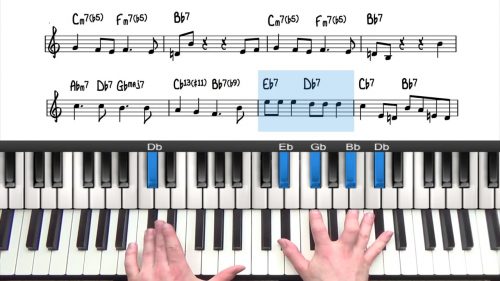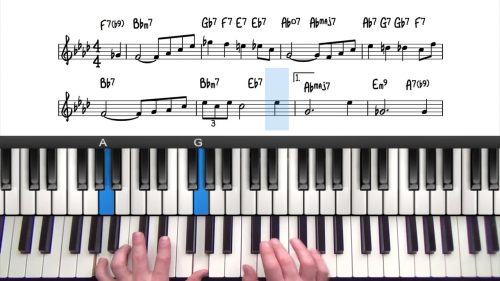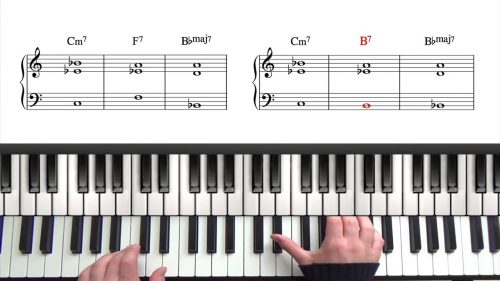Autumn In New York Tutorial
Written in the key of F Major, Autumn in New York is most often played as a ballad and it follows a 32 measure A1 – B – A2 – C form. The tonality is primarily major and the descending melodic motive repeats throughout the tune.
We’re going to jump straight in with some two handed voicings and look for opportunities to enhance the harmony using upper structure triads, passing chords and suspensions. Check out those lessons for specific guidance on each of these areas of theory.
Autumn In New York is a true cocktail piano classic and is a popular and well-known tune to add to your repertoire!
Comments
12 Comments
Leave Comment







Hello Hayden: what intro (from among those for which you already have videos) would you recommend for this tune? Not that it necessarily needs it but….
Thanks, Smole
Hey Smole… great question.
The tune is written in F major, but we start on the ii-7 chord (G-7 is the ii-7 chord in the key of F Major).
Have a play around with this… a 1-6-2-5 in the key of F to establish the F Major tonality.
Fmaj7
D7alt – perhaps try a D7 with different upper structure triads
G-7
C7 – perhaps try a C7 with different upper structure triads
—> back to Fmaj7
Then here’s a nice chromatic idea to land on the G-7
Fmaj7
Bb7 – experiment with extensions and alterations
A7 – experiment with extensions and alterations
Ab7 – experiment with extensions and alterations
—> G-7 to start the tune
Ab7 is the tritone substitute of D7 and also a half step above G-7 the starting chord. This will create a nice chromatic entrance to the tune.
Play around with this and let me know what you think.
Cheers!
Hayden
Outstanding, Hayden, I love options. Now I’ll try all of them to see which one(s) would be best. Thanks kindly. Smole
My pleasure Smole.
Hello Hayden: I tried both and I like the second (chromatic) intro better especially since it allows for experimenting with extensions and can be really smooth if played well (which I am trying, not there yet). Thanks really, Smole
Brilliant… I’m glad you like the suggestions. I use this kind of thing a lot in my playing. It’s nice to know that you can stack chromatic dominant chords one after the other, to get to any target chord. A useful ‘trick’ to know!
Also, you can mix both options together. The first option is just a standard 1-6-2-5 progression in F which is the key of the tune. You could perhaps play this once or twice – or as many times as you like! – remember that the 1-6-2-5 is a cyclical progression always taking you back to the 1 … F Major in this case.
Then when you are ready to start the tune, play the 1 again (F Major) and then add in the chromatic sequence to target the G-7 where the tune starts.
I like the following voicings for the chromatic sequence:
Fmaj9
Bb9#11 – shell in the left hand (root and b7) and then 9 and #11 in the right hand (C and E)
A7b9#5 – shell in left hand (root and b7) and then b9-3-#5 in the right hand (Bb, C#, and F)
Ab13b9 – again shell in left (root and b7) and then an F major triad in the right hand in second inversion, gives you 3-13-b9, with the b9 (A) in the melody. I like to hang there for a little while – really let that b9 hang there :-) – and then drop into the tune. You could also arpeggiate that F Triad up the piano in your right hand which can be a nice effect.
Have fun playing around with this stuff :-)
Cheers!
Hayden
Hiya Hayden,
I am really starting to see the light, unfortunately as a teacher, I always watch the didactics of how you teach and I must say you bring it all across beautifully. There is one point however, that I think can be thought about, whether you decide to apply it or not is of course, your choice; If you look at the first line of the melody above, you arrive at the Fmaj7 and there is a choice that you obviously make in choosing these voicings and notes, but you seldom tell us what your reasoning is behind your choices, and I believe, though it is my humble opinion, that this would have a great impact on my learning, though I cannot speak for all here. For example, is it because of the lightness of where the tune is here or the relation to the D and A notes that follow?
Anyway, keep up the great work, my days are filled with curiosity and learning since I discovered this site
Regards
Bill K
Bill, I think what will help is if you learn the words to the song. Also listen to a few well known artist who covered it and that will lead you to the right direction on chord choices. This song definitely moves between major and minor tonalities, therefore someplace you will need chords that sound more bright vs dark. You can also substitute certain Chords with the melodic minor and that will further darken things. these are the choices you have, there is not right or wrong
Hiya Milton
Thank you so much for your wise words, indeed jazz is a tough.mistress, she seldom takes the well-worn path but demands that you use your own map, and this is a steep learning curve for me, but extremely interesting, having played a purely melody only instrument for a long time does influence me. Your words bring hope, and hope keeps one moving in a direction be it good or bad, hopefully good.
Thanks a million Milton
Warm Regards
Bill k
Hi Hayden,
I have seen the Right hand Position for the D alt above (minute mark, 9:12) as the ii in the minor 2-5-1 of Bb minor. Could you please explain the logic on how it is used interchangeably in this context? What other chords can be put in the same context as the D alt above?
Thank You,
Best Regards,
Timothy Sutiono
A quick question about the transcription and/or a grammar lesson about accidentals.
In measure 8 for the D7(#9#5) you have a shell in the left hand and and the low note in the right hand is an F#. The highest note is written without an accidental and must therefore be an F natural right? One could put a courtesy natural in parens. The second high F has a natural marking? Does this imply you wanted an F# on the first high F? This I doubt in that the chord at beat 1.5 is simply the same voicing as the one an octave below. If this is a typo fine but isn’t it true that an accidental carries all the way through a measure for the SAME NOTE and does not effect other notes octaves away. Is that right?
Also you need a flag off the low F natural in measure 9.
LOVE the arrangement!
John
Hi John,
Thanks for letting me know about this and yes you are correct that the low F# is the natural 3rd of D7, and the high F is an F natural which is the #9 of D7. This creates the D7#5#9 chord.
Yes I agree it would be clearer with the natural sign in the higher register. I will add this to the PDF. If ever in doubt please follow what is being played and demonstrated in the actual video lesson. Jazz chords are often a little confusing when notated, exactly due to this kind of thing.
I’m glad you like the arrangement – it’s also one of my favourites! My arranging skills are apparently sharper than my notation skills! :–)
Thanks again for letting me know about this and I will fix the PDF file shortly.
Cheers,
Hayden